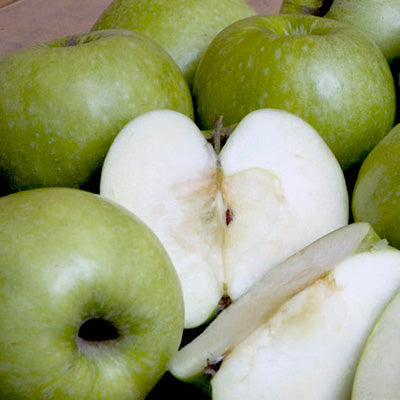Plant Hoarder
Apple, Granny Smith
Apple, Granny Smith
Couldn't load pickup availability
Share
Hardiness Zone:4, 5, 6, and 7
Sun Exposure:Full Sun
Apple 'Granny Smith' on Geneva® 969 Rootstock – A Crisp Classic with Modern Strength
Few apples are as iconic as the ‘Granny Smith’. With its brilliant green skin, crisp bite, and bold tartness, it’s a favorite for fresh snacking, baking, and cider alike. But when you pair this timeless apple with the Geneva® 969 rootstock, you get a tree that’s not only productive and manageable, but also tough, disease-resistant, and perfect for modern home orchards.
Let’s dive into what makes this combination so special—and how you can successfully grow it from bare-root to harvest.
Why Grow 'Granny Smith'?
The ‘Granny Smith’ is more than just a grocery store favorite. It’s a vigorous grower that ripens late, typically in October or November, delivering a strong finish to the growing season. Here’s why gardeners love it:
-
Bright green skin with a slight yellow blush when fully ripe
-
Firm, crisp texture that holds up in baking
-
Tart, refreshing flavor that mellows with storage
-
Excellent keeper—can store for up to 6 months in cool conditions
-
Self-fertile, though it produces more with a pollinator
This is a great apple for USDA zones 6–9, especially in areas with mild winters and warm summers.
Geneva® 969 Rootstock: Small Tree, Big Results
Geneva® 969 brings the best of both worlds—compact growth and high performance. Here’s what you can expect:
-
Semi-dwarf size: Grows to 10–12 feet tall with pruning
-
Early bearing: Fruits as early as Year 2 or 3
-
Resistant to fire blight and crown rot
-
Cold hardy and well anchored
-
Ideal for home gardens and orchards
In other words, this rootstock helps make a legendary apple easier to grow and maintain—without compromising on fruit size or quality.
Shipped Bare-Root: What to Expect
We ship your apple tree bare-root and dormant in winter, and leafed out (but still bare-root) during the rest of the growing season. That means:
-
You receive the tree without soil, making it lighter and easier to plant
-
In winter, the tree arrives dormant, appearing like a bare stick—but it's very much alive
-
In spring, summer, and early fall, the tree is leafed out, showing growth and ready to settle into your garden quickly
This method of shipping ensures a stronger root system, faster establishment, and more successful long-term growth.
How to Plant Your ‘Granny Smith’ Bare-Root Tree
Getting off to a good start is simple. Here’s how to do it right.
Best Time to Plant:
-
Winter through early spring: Plant dormant trees as soon as the ground is workable
-
Spring through early fall: For leafed-out trees, plant as soon as possible and water thoroughly
Step-by-Step Planting Guide:
-
Soak the roots in water for 4–6 hours before planting (especially important for dormant trees).
-
Dig a hole twice as wide as the root spread and deep enough to accommodate the roots naturally.
-
Set the tree so the graft union (the swollen area above the roots) is 2–3 inches above the soil line.
-
Backfill with native soil, gently firming to eliminate air pockets.
-
Water deeply to help settle the roots.
-
Add mulch, leaving a few inches around the trunk clear.
Pro Tip: Stake your tree for the first 1–2 years, especially if it’s exposed to wind. Geneva® 969 has strong anchoring but benefits from extra support while establishing.
Sun, Soil, and Water – Easy Growing Tips
Like most apple trees, ‘Granny Smith’ loves the sun and well-drained soil. Let’s walk through the basics of care:
Light:
-
Full sun—6 to 8 hours of direct sunlight daily
Water:
-
Water deeply once per week, more often in hot or dry weather
-
Avoid letting the roots sit in soggy soil
Soil:
-
Prefers loamy, well-drained soil
-
A slightly acidic to neutral pH (6.0 to 7.0) is ideal
Fertilizer:
-
Use a balanced slow-release fertilizer in early spring
-
Don’t overfeed—too much nitrogen can reduce fruiting
Pruning:
-
Prune while the tree is dormant in late winter
-
Create an open shape to encourage airflow and light
-
Remove any suckers from below the graft union
Pollination & Fruit Production
While 'Granny Smith' is partially self-fertile, you’ll get more and better fruit if you plant it with a pollination partner.
Great partners include:
-
Fuji
-
Gala
-
Golden Delicious
-
Honeycrisp
Plant them within 50 feet of each other for the best pollination. If space is tight, try a multi-variety tree or invite neighborhood bees to do the work by planting flowers nearby.
Harvest Time: A Reward Worth Waiting For
‘Granny Smith’ is a late-season apple, ripening in October through November. You'll know it's ready when:
-
The apples are bright green with a slight yellow blush
-
Fruit is firm and crisp
-
A few apples start dropping naturally from the tree
These apples are perfect for:
-
Pies, crisps, and other desserts
-
Slicing fresh with cheese
-
Making cider or applesauce
-
Long-term storage
Store in a cool, dry place—‘Granny Smith’ apples keep for months!
Growth Timeline: What to Expect
Year 1 – Root Establishment
-
Leaf growth above ground
-
Root development below ground
-
Focus on watering and shaping
Year 2 – First Flowers
-
Some trees may bloom, especially in warm zones
-
Light crop possible
Year 3–5 – Full Fruiting
-
Regular harvests begin
-
Strong yearly pruning helps keep the tree productive
Why You'll Love This Tree
The pairing of ‘Granny Smith’ with Geneva® 969 rootstock brings you the best of old and new:
-
A classic apple known and loved around the world
-
Compact size for small gardens and orchards
-
Disease resistance for fewer problems and sprays
-
Late harvest to extend your apple season
-
Bare-root shipping for strong roots and faster growth
Whether you’re planting your first apple tree or expanding your orchard, this is a tree that delivers—on taste, toughness, and ease of care. The moment you bite into that first tart, juicy apple you grew yourself, you’ll be hooked.


